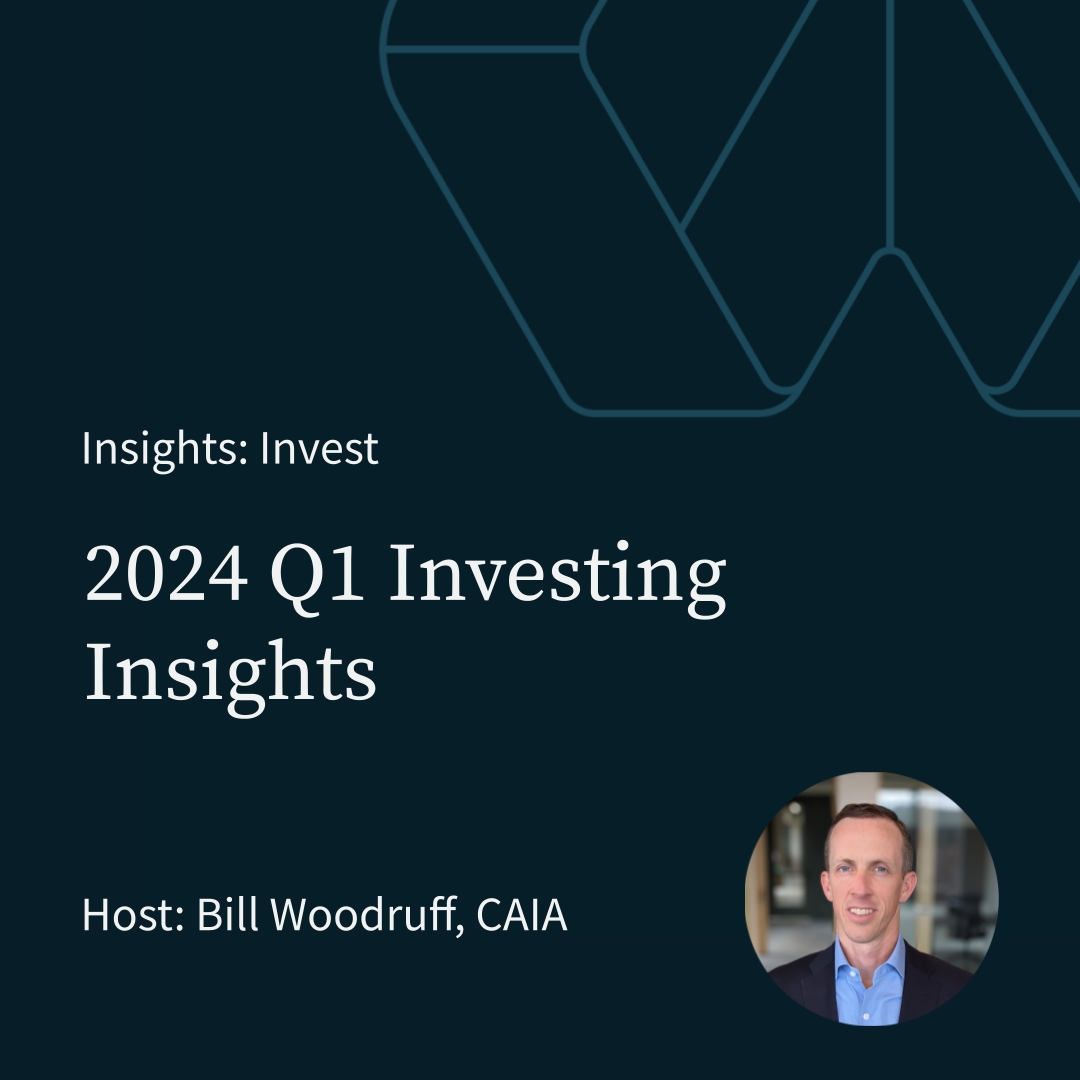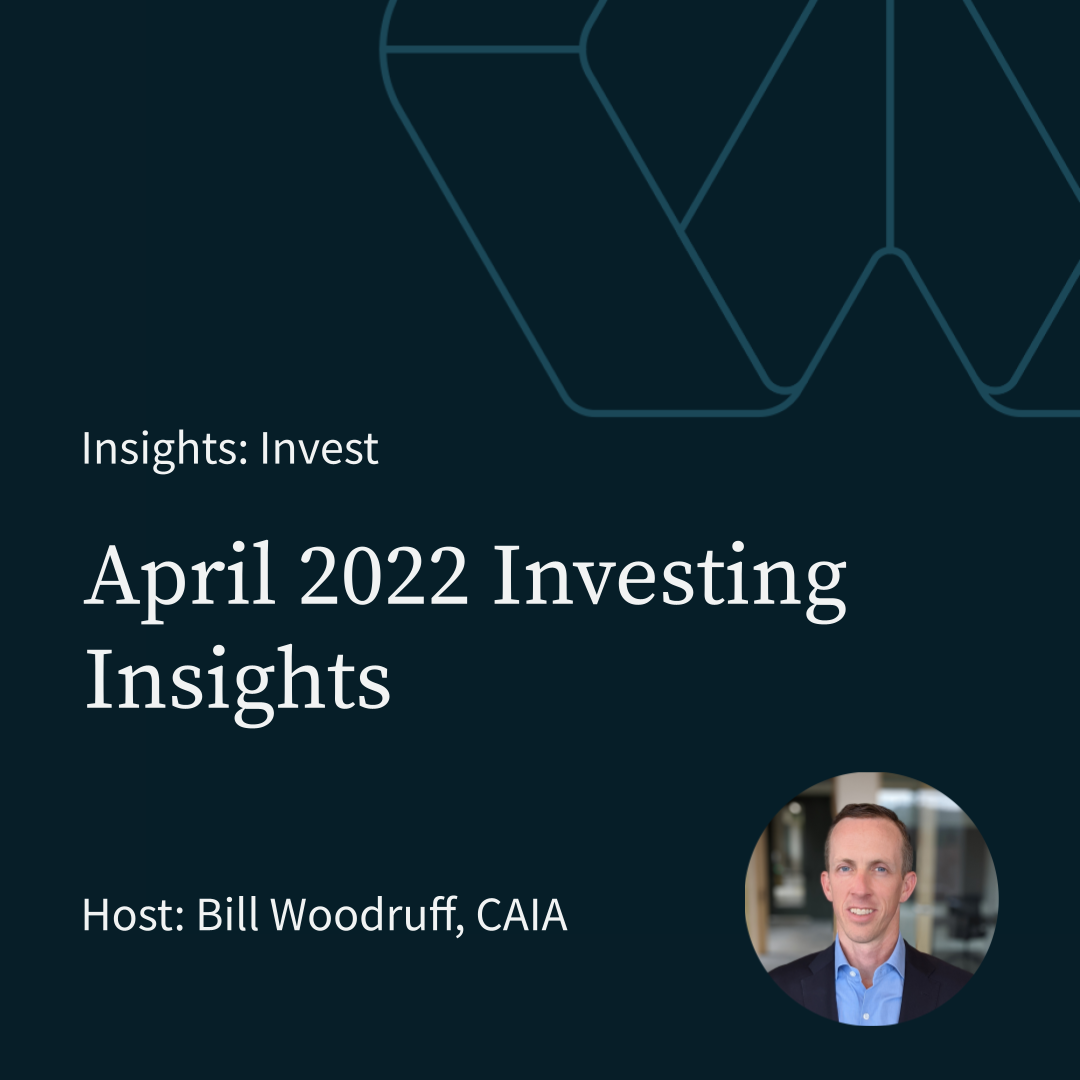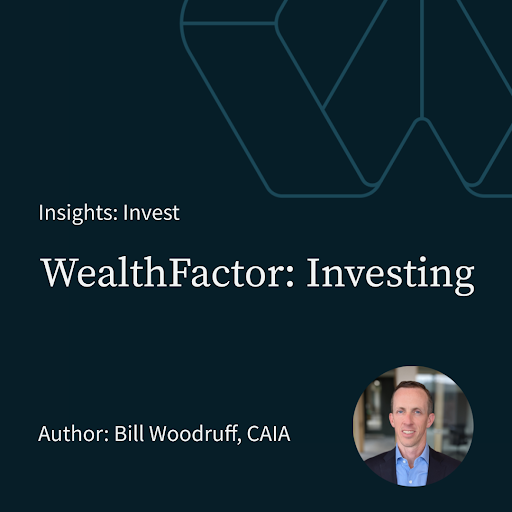WealthFactor Review & Update: February 2021
Replay:
Slides:
Transcript:
SUMMARY KEYWORDS
portfolio, valuation, risk, investment, sectors, yield, wealth, services, stocks, year, clients, pe, potential, layers, fixed income, return, factor, relative, terms, weighting
0:00
Good afternoon. Welcome to the February 2021, wealth factor review and update for global financial markets and investing. My name is Bill Woodruff. I am the founder and responsible for the investment services at wealth factor. Before I get too far in a few words for compliance purposes, this call is for informational purposes only and may be recorded statements made during this call or the opinions of the speaker, and are subject to risks and uncertainties, some of which are significant in scope, and by their very nature, beyond the control of wealth factor, there can be no assurance that such statements will prove to be accurate, and actual results and future events could differ in a material way from said statements. Historical results are not necessarily indicative of future performance. By way of background, I've spent about 20 years focused in investing across a variety of different capacities, both in relatively small businesses, as well as in capacity as managing director at the public company, fortress Investment Group. Well factor is comprised of a team of specialists and experts. Well factor is a Lake Oswego based investment advisor, we offer two service types, a wealth planning, service, and a investment planning and implementation service.
1:46
Our investment services are centered around personalized portfolios. Most of what we do is, is based on indices and typically comprised of stocks and or bonds. When we offer our service Investment Services accounts are held in our clients names at independent third party custodians. Our business is built and centered around our innovative fee model of point three 5% on assets that we manage. So today, we're going to spend some time primarily centered around some research, I think, is really insightful and interesting provided or conducted by dimensional fund advisors. But we're going to be looking at what's been driving markets in both the recent term as well as kind of the last several years. And and and then take that and think that through relative to how should one be thinking about investing and building portfolios today, it's my belief that there is a significant amount of market participants are operating under the idea that the dynamics of what takes what drives successful investing is now suddenly different. And so this research I'm going to share go through today, I, you know, I think makes a fairly strong case against that conceptually. Secondly, I'm going to spend a little bit of time looking at at the dynamics of fixed income, we've seen rates start to go up to start this year, and come off of incredibly low levels. So just Just a quick note, in terms of our approach internally, from an investment perspective, we do operate under an investment philosophy, which we call risk smart. risk. Smart is an evidence based process that focuses on three different component parts, portfolio or risk fees, as well as taxes. And in offering or building personalized portfolios, it's my belief that the best way one can add value and optimize the probability of a successful outcome is through a focus on being simple and very, very efficient. So diving into some of the prepared slides and comments. So this graph has lots of information, I actually use this slide last month as well. And I didn't put the red circles on it. And so I am using it again this month, partly because the visuals a little bit better with the red, but also just because it's so related to what I think is a core issue with how the average mini market participants are approaching investing today. So what this is, is a visual representation of the difference of a set of categories or types of stocks. So momentum, quality, value size, are really the key and core elements there, this breaks it down to a few others. And then the gray one, or off white is multi factor, which represents a diversified portfolio. This is this is something you'll see from an asset class perspective, as well as a sector perspective as well. But in this particular case, we're looking at FACTOR performance and consistent to all sorts of things, you'll see a diversified multi factor approach, tend not to have the sorts of extremes that individual factors do, and so on this, so I'm using this today to highlight the momentum factor. And it's my belief that there's likely a correlation or relationship between the six recent or near term success of the momentum factor and investor comfort or confidence in picking stocks. And the basis for that concept for me, is the idea that the if you're going to pick stocks, whether you're a professional investor, or somebody who does it for their own purposes,
6:29
separate from being a professional investor, the if your universe is of what you might invest in, is driven in part by what did well yesterday, your short run success as an investor is likely to be better when the momentum factors doing well. And as we can see, over this, 14 or so year, 15, year period, recently, 2020, not necessarily year to date, but 20 2019 1817. And obviously, there was a blip and 16. But really, those recent years, the momentum factor has consistently been at that top. However, if you look at the momentum factor over the full period, the results are far more diverse. And this sort of analysis across lots of different things, not just factors, but sectors and asset classes, is pretty consistent, where it's one very difficult to predict what might do well, tomorrow. And then it's not there's almost never in these sorts of analyses, a consistent winner. So today, I'm going to focus in on the two elements, what drives overall markets, broad market returns in this and then also, what is it if we look at and this is the research I mentioned, largely driven by dimensional fund advisors, if we look at big companies are the companies that did well yesterday. And, you know, what does that mean? You know, should we be basing our current portfolio construction or picking of positions based on that. And so with what this particular graph is showing, is a very broad swath of us publicly traded companies, and a distribution of those that outperform the market on the far right and underperform the average stock in the market on the left. And, and this is consistent with research to say that there's a, you know, some small, typically smaller universe of stocks, that drives the overall markets return. And then on here, we've got Fang stocks specifically. So Facebook, Amazon, apple, alphabet, slash Google, Netflix, etc, and their performance. And so you can see most all of these over the last eight years or since, or almost nine, this is through November of 2020. Is are above average performers. So the first analysis step will take is well, let's rewind to the starting point of this and say, Okay, what were the largest so many of these companies, the Fang stocks represent the largest tech companies or companies in general today. Well, let's rewind and say okay, from that starting point, eight years ago, if we were to invest in the 10 largest tech stocks or companies, what would that have performance look like? And the data actually shows that, on average, while you do have those big winners, more than half of those largest companies underperformed, actually the average performer in public companies or markets. The next step in terms of evaluating and spending time thinking through this concept is looking back over a much longer period of time. So it's so easy to get very recency focused. And there's, there's a fair amount of psychological or behavioral research that focuses on the recency bias. But I think it's really important to take whatever we're, you know, really critically evaluate our approach to portfolio construction and say, Does this really make sense? And, and should I be doing it this way? And so as I, as we start to unpack the, this concept of, you know, should we be investing in what's done well, yesterday, or what are now the more prominent names, this analysis looks all the way back to 1927.
11:06
And it's showing, it's identifying individual companies over different sorts of time periods, and the in the bars and the different colors, and then the line represents the annualized compound compound return for the overall market. And so the bars really represent, you know, of what percentage of the overall markets return, were driven by, you know, effectively a single company. And so this analysis really shows that the and there's I don't know whether this is a pro prevailing idea in the market, but that it's not new, that a handful of winners, largely can drive overall market returns. So the idea that say, Apple has been the place to be, from an investment perspective for quite some time, is not a new concept. I as I think about this, from a portfolio perspective, this isn't some sort of basis for trying to find the next apple. So this in combination with the prior slide, really is one where it's, I think, it largely says suggests that one needs to really question the idea that being invested in yesterday's winners, or trying to find what's going to drive tomorrow's returns is likely a very challenging and luck based endeavor. So you know, just kind of before I move on to fixed income, just to kind of summarize some thoughts in regards to that set of content and those those concepts and ideas. I feel, I believe that one should think very carefully about the a lot of things in terms of how they approach investing, starting at this the top level of how do I generate my universe of potential investments? And then what, you know, what is my process around what I end up investing in? And am I subject to things like momentum, or recency bias, or overconfidence, or a variety of those sorts of things in what I'm doing? And how repeatable is that? And then, from a Fang stock perspective, and I guess there's a newer acronym that, you know, based on the current, I guess, what you would call flavor of the week is fan mag, you know, these sorts of things are not new, there's been a variety of different sorts of acronyms that are, are the, again, the flavor of the week, whether it's the nifty 50, or I remember a time when it was brick, or watch, which was, you know, who that was Walmart. So, I don't think I think as I reflected on this research and spent some time within wrestled with it, it for me, reinforces my belief, that even though it, it's natural, and a human tendency to try to say about, you know, try to believe that something's different about the dynamics of markets. This research for me really suggests that that's probably not the case that the the, you know, if we statistically evaluate the drivers for market returns, I don't think that I think it's very difficult to sit try to conclude that the market dynamics today are different, or what might drive return. So transitioning the conversation to spend a little bit of time on fixed income, fixed income has been a very challenging place. And when I think about the use most useful element for fixed income, you know, there's two drivers stability, as well as income generation and And so while this is still true at what we said, what we've seen so far this year is a fairly material, especially as you think about it in terms of percentage of total amount of income that's being driven by the yield component of treasuries increased fairly significantly in in just the first two months of this year. So what this graph is on the left, just to share context is the Treasury yields, with the blue being the end of 2020, and the red being as of the end of February. And so we can see that the five year Treasury more than doubled its yield, the 10 year had a fairly material uptick, and so did the 30. year. And and so, you know, really this is, while so it's important to pause and
15:57
note that when rates rise, bond prices fall, impacting the short term performance of fixed income. And if you're investing if you're an investor, you don't really care about this, or you shouldn't, you know, the goal really, for an overall investment program or plan shouldn't be built around, in my opinion, exit timing, which if if you're worried about what might happen to a bond in the short term, then you're really building an investment program that's built around when I might exit something. Whereas if you're a true investor and utilizing this for the what, potentially how it can potentially benefit a portfolio, you're more thinking about it in terms of it as a stabilizer, because while this hasn't necessarily been true, in the short run, it tends to be not correlated to risk, we have seen in in just recent days or weeks, amount of correlation to stocks going down, and bonds going down at the same time. So the you know, as interest rates, Treasury yields, especially high quality, fixed income, interest rates rise potentially, I think it's important to continue to think about and reevaluate overall asset allocations. And a big part of what we're focused on is what well factor is trying to identify the right amount of risk for each one of our clients. And then based on that right risk, right amount of risk, looking to avoid unnecessary risk whenever possible. And while the 10 year Treasury at 1.44%, is still historically very, very low. And as that goes up, the potential benefits start to have the yield as well as the diversification benefits start to increase dramatically. And Warren, I think considerations relative to other types of assets. The on the right side of this graph is high yield, or junk bonds effectively. And so we can see that there's there was a slight uptick in those yields, but it was very slight. And on the far right side, we have the spread, which is effective between the high yield, yield and the 10 year Treasury. And you can and so that's basically high yield of 4.25%. Today, minus the 10. Year yield 10. year Treasury yield of 1.44. And you can see the spread fell. And as if you're thinking about this, from an investor perspective, not one worried about exit timing, or speculating on what might happen to these prices, the analysis ought to be, you know, am I getting paid for taking the extra risk associated with lower quality, fixed income? versus owning treasuries? And the answer to that is less so today at 2.81% have spread to the 10 year versus 3.25%. It's not a perfect apples to apples comparison, which is worth noting, in that the average maturity for the particular high yield universe used here is only 6.5 years. So it's actually has less interest rate risk, but it's relatively close enough for the purpose of illustrating the concept. So that concludes my prepared comments. If you have any questions, please don't hesitate to reach out directly. I've shared my both the phone number for wealth factor as well as my email and I'd be happy to address any of those questions offline. Enjoy the rest of your day.
Good afternoon. Welcome to the February 2021, wealth factor review and update for global financial markets and investing. My name is Bill Woodruff. I am the founder and responsible for the investment services at wealth factor. Before I get too far in a few words for compliance purposes, this call is for informational purposes only and may be recorded statements made during this call or the opinions of the speaker, and are subject to risks and uncertainties, some of which are significant in scope, and by their very nature, beyond the control of wealth factor, there can be no assurance that such statements will prove to be accurate, and actual results and future events could differ in a material way from said statements. Historical results are not necessarily indicative of future performance. By way of background, I've spent about 20 years focused in investing across a variety of different capacities, both in relatively small businesses, as well as in capacity as managing director at the public company, fortress Investment Group. Well factor is comprised of a team of specialists and experts. Well factor is a Lake Oswego based investment advisor, we offer two service types, a wealth planning, service, and a investment planning and implementation service.
1:46
Our investment services are centered around personalized portfolios. Most of what we do is, is based on indices and typically comprised of stocks and or bonds. When we offer our service Investment Services accounts are held in our clients names at independent third party custodians. Our business is built and centered around our innovative fee model of point three 5% on assets that we manage. So today, we're going to spend some time primarily centered around some research, I think, is really insightful and interesting provided or conducted by dimensional fund advisors. But we're going to be looking at what's been driving markets in both the recent term as well as kind of the last several years. And and and then take that and think that through relative to how should one be thinking about investing and building portfolios today, it's my belief that there is a significant amount of market participants are operating under the idea that the dynamics of what takes what drives successful investing is now suddenly different. And so this research I'm going to share go through today, I, you know, I think makes a fairly strong case against that conceptually. Secondly, I'm going to spend a little bit of time looking at at the dynamics of fixed income, we've seen rates start to go up to start this year, and come off of incredibly low levels. So just Just a quick note, in terms of our approach internally, from an investment perspective, we do operate under an investment philosophy, which we call risk smart. risk. Smart is an evidence based process that focuses on three different component parts, portfolio or risk fees, as well as taxes. And in offering or building personalized portfolios, it's my belief that the best way one can add value and optimize the probability of a successful outcome is through a focus on being simple and very, very efficient. So diving into some of the prepared slides and comments. So this graph has lots of information, I actually use this slide last month as well. And I didn't put the red circles on it. And so I am using it again this month, partly because the visuals a little bit better with the red, but also just because it's so related to what I think is a core issue with how the average mini market participants are approaching investing today. So what this is, is a visual representation of the difference of a set of categories or types of stocks. So momentum, quality, value size, are really the key and core elements there, this breaks it down to a few others. And then the gray one, or off white is multi factor, which represents a diversified portfolio. This is this is something you'll see from an asset class perspective, as well as a sector perspective as well. But in this particular case, we're looking at FACTOR performance and consistent to all sorts of things, you'll see a diversified multi factor approach, tend not to have the sorts of extremes that individual factors do, and so on this, so I'm using this today to highlight the momentum factor. And it's my belief that there's likely a correlation or relationship between the six recent or near term success of the momentum factor and investor comfort or confidence in picking stocks. And the basis for that concept for me, is the idea that the if you're going to pick stocks, whether you're a professional investor, or somebody who does it for their own purposes,
6:29
separate from being a professional investor, the if your universe is of what you might invest in, is driven in part by what did well yesterday, your short run success as an investor is likely to be better when the momentum factors doing well. And as we can see, over this, 14 or so year, 15, year period, recently, 2020, not necessarily year to date, but 20 2019 1817. And obviously, there was a blip and 16. But really, those recent years, the momentum factor has consistently been at that top. However, if you look at the momentum factor over the full period, the results are far more diverse. And this sort of analysis across lots of different things, not just factors, but sectors and asset classes, is pretty consistent, where it's one very difficult to predict what might do well, tomorrow. And then it's not there's almost never in these sorts of analyses, a consistent winner. So today, I'm going to focus in on the two elements, what drives overall markets, broad market returns in this and then also, what is it if we look at and this is the research I mentioned, largely driven by dimensional fund advisors, if we look at big companies are the companies that did well yesterday. And, you know, what does that mean? You know, should we be basing our current portfolio construction or picking of positions based on that. And so with what this particular graph is showing, is a very broad swath of us publicly traded companies, and a distribution of those that outperform the market on the far right and underperform the average stock in the market on the left. And, and this is consistent with research to say that there's a, you know, some small, typically smaller universe of stocks, that drives the overall markets return. And then on here, we've got Fang stocks specifically. So Facebook, Amazon, apple, alphabet, slash Google, Netflix, etc, and their performance. And so you can see most all of these over the last eight years or since, or almost nine, this is through November of 2020. Is are above average performers. So the first analysis step will take is well, let's rewind to the starting point of this and say, Okay, what were the largest so many of these companies, the Fang stocks represent the largest tech companies or companies in general today. Well, let's rewind and say okay, from that starting point, eight years ago, if we were to invest in the 10 largest tech stocks or companies, what would that have performance look like? And the data actually shows that, on average, while you do have those big winners, more than half of those largest companies underperformed, actually the average performer in public companies or markets. The next step in terms of evaluating and spending time thinking through this concept is looking back over a much longer period of time. So it's so easy to get very recency focused. And there's, there's a fair amount of psychological or behavioral research that focuses on the recency bias. But I think it's really important to take whatever we're, you know, really critically evaluate our approach to portfolio construction and say, Does this really make sense? And, and should I be doing it this way? And so as I, as we start to unpack the, this concept of, you know, should we be investing in what's done well, yesterday, or what are now the more prominent names, this analysis looks all the way back to 1927.
11:06
And it's showing, it's identifying individual companies over different sorts of time periods, and the in the bars and the different colors, and then the line represents the annualized compound compound return for the overall market. And so the bars really represent, you know, of what percentage of the overall markets return, were driven by, you know, effectively a single company. And so this analysis really shows that the and there's I don't know whether this is a pro prevailing idea in the market, but that it's not new, that a handful of winners, largely can drive overall market returns. So the idea that say, Apple has been the place to be, from an investment perspective for quite some time, is not a new concept. I as I think about this, from a portfolio perspective, this isn't some sort of basis for trying to find the next apple. So this in combination with the prior slide, really is one where it's, I think, it largely says suggests that one needs to really question the idea that being invested in yesterday's winners, or trying to find what's going to drive tomorrow's returns is likely a very challenging and luck based endeavor. So you know, just kind of before I move on to fixed income, just to kind of summarize some thoughts in regards to that set of content and those those concepts and ideas. I feel, I believe that one should think very carefully about the a lot of things in terms of how they approach investing, starting at this the top level of how do I generate my universe of potential investments? And then what, you know, what is my process around what I end up investing in? And am I subject to things like momentum, or recency bias, or overconfidence, or a variety of those sorts of things in what I'm doing? And how repeatable is that? And then, from a Fang stock perspective, and I guess there's a newer acronym that, you know, based on the current, I guess, what you would call flavor of the week is fan mag, you know, these sorts of things are not new, there's been a variety of different sorts of acronyms that are, are the, again, the flavor of the week, whether it's the nifty 50, or I remember a time when it was brick, or watch, which was, you know, who that was Walmart. So, I don't think I think as I reflected on this research and spent some time within wrestled with it, it for me, reinforces my belief, that even though it, it's natural, and a human tendency to try to say about, you know, try to believe that something's different about the dynamics of markets. This research for me really suggests that that's probably not the case that the the, you know, if we statistically evaluate the drivers for market returns, I don't think that I think it's very difficult to sit try to conclude that the market dynamics today are different, or what might drive return. So transitioning the conversation to spend a little bit of time on fixed income, fixed income has been a very challenging place. And when I think about the use most useful element for fixed income, you know, there's two drivers stability, as well as income generation and And so while this is still true at what we said, what we've seen so far this year is a fairly material, especially as you think about it in terms of percentage of total amount of income that's being driven by the yield component of treasuries increased fairly significantly in in just the first two months of this year. So what this graph is on the left, just to share context is the Treasury yields, with the blue being the end of 2020, and the red being as of the end of February. And so we can see that the five year Treasury more than doubled its yield, the 10 year had a fairly material uptick, and so did the 30. year. And and so, you know, really this is, while so it's important to pause and
15:57
note that when rates rise, bond prices fall, impacting the short term performance of fixed income. And if you're investing if you're an investor, you don't really care about this, or you shouldn't, you know, the goal really, for an overall investment program or plan shouldn't be built around, in my opinion, exit timing, which if if you're worried about what might happen to a bond in the short term, then you're really building an investment program that's built around when I might exit something. Whereas if you're a true investor and utilizing this for the what, potentially how it can potentially benefit a portfolio, you're more thinking about it in terms of it as a stabilizer, because while this hasn't necessarily been true, in the short run, it tends to be not correlated to risk, we have seen in in just recent days or weeks, amount of correlation to stocks going down, and bonds going down at the same time. So the you know, as interest rates, Treasury yields, especially high quality, fixed income, interest rates rise potentially, I think it's important to continue to think about and reevaluate overall asset allocations. And a big part of what we're focused on is what well factor is trying to identify the right amount of risk for each one of our clients. And then based on that right risk, right amount of risk, looking to avoid unnecessary risk whenever possible. And while the 10 year Treasury at 1.44%, is still historically very, very low. And as that goes up, the potential benefits start to have the yield as well as the diversification benefits start to increase dramatically. And Warren, I think considerations relative to other types of assets. The on the right side of this graph is high yield, or junk bonds effectively. And so we can see that there's there was a slight uptick in those yields, but it was very slight. And on the far right side, we have the spread, which is effective between the high yield, yield and the 10 year Treasury. And you can and so that's basically high yield of 4.25%. Today, minus the 10. Year yield 10. year Treasury yield of 1.44. And you can see the spread fell. And as if you're thinking about this, from an investor perspective, not one worried about exit timing, or speculating on what might happen to these prices, the analysis ought to be, you know, am I getting paid for taking the extra risk associated with lower quality, fixed income? versus owning treasuries? And the answer to that is less so today at 2.81% have spread to the 10 year versus 3.25%. It's not a perfect apples to apples comparison, which is worth noting, in that the average maturity for the particular high yield universe used here is only 6.5 years. So it's actually has less interest rate risk, but it's relatively close enough for the purpose of illustrating the concept. So that concludes my prepared comments. If you have any questions, please don't hesitate to reach out directly. I've shared my both the phone number for wealth factor as well as my email and I'd be happy to address any of those questions offline. Enjoy the rest of your day.
WealthFactor, LLC has withdrawn its registration as an investment advisor and does not currently offer any investment advisory services. All information is being shared for educational purposes only and should not be construed as an offer to buy or sell any security or service of any kind. Please consult with the proper professional services provider prior to acting on any information contained within this site.
© 2024 WealthFactor All Rights Reserved.










